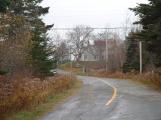14
This contemporary photograph shows all that remains of the dam built by mill owners John G. and Andrew Mitchell. The dam forms part of a circular walk constructed by the community. The walk crosses over the dammed tidal entrance to the ponds and loops back along the former highway.16
During the early 1900s, lumber and fishing were the backbone of the Oyster Pond economy. In this photograph by Amos Myers, the buildings from left to right are: shed, house and barn of Amos Webber; workshop of Fred H. Stoddard; warehouse of Arthur Webber; and the mill of John G. and Andrew Mitchell. Just behind the mill, another roof is barely visible. This is the mill of David Mitchell (b.1831, d.1908), a brother of John and Andrew. The flat roofed building of carpenter and undertaker Fred Stoddard is typical of his building style. Fred was responsible for many of the flat-roofed buildings in the area, including the Mitchell / Hosking store.In an interview from 2004, Reginald Daye recalls Fred Stoddard's son, Tom, who carried on the carpentry and undertaking business out of the building (flat roof, centre) in this picture:
"Poor old Tom. I helped dig quite a few graves when he was undertaking. Now this was a carpenter's shop and he made the caskets in there, and we'd look in through the windows, going to school. Make baby caskets, and grown up ones. He used to line them with a flannel, a grey flannel, and carpet tacks."
17
Buildings from early 1900s seen across the dammed portion of the pond.10 November 2004
Oyster Pond, Nova Scotia

18
This is a contemporary photograph of what was Amos Webber's homestead (seen in the 1915 image preceding this one). The flat-roofed house is just visible through the trees. The barn is at the edge of the stone wall, which now borders one side of the Oyster Pond walking trail.20
As in the other photograph by Amos Myers from 1915, the home and shed of Amos Webber are in the foreground on the left. Immediately behind Amos Webber's shed, is the shingled sawmill of John G. and Andrew Mitchell.The large house above the mill belonged to Arthur Webber. To the right is Arthur's barn, which was once the Anglican rectory and was moved down from Rectory's Hill. The original location of this house was on the hill above the house on the far right, which was owned by John G. Mitchell.
22
This contemporary photograph shows the highway as it passes through Oyster Pond, dissecting the hill that can be seen in the previous image. This house (the former home of John G. Mitchell) is seen on the far right of the previous image.24
Oyster Pond has always relied on its natural resources. Even during the 1930s the downturn in the economy was offset somewhat by the rise of the local pulpwood industry. Loading pulpwood onto steamships moored in the harbour was a dangerous job, with very poor pay, but "at least it was a job."Mr. Mitchell recalls how treacherous it was:
"I don't remember any vessels after we'll say the mid 1930s. But the most active thing, right in the Harbour here, was, see, pulpwood got to be a big thing. And that created a lot of work in the woods during Depression time. But I don't know what the people would have done without it.
But that was all loaded either in this harbour or in Ship Harbour. And these would be, you know, steam driven ships would come in. These ships would come in the summer time. But if a ship come in now, and loaded, it may be back here the next week. So there was them spells in between. But somebody would be working in preparing for the next load of wood to be. See they loaded that right out of the water. It was boomed out to them. It wasn't loaded ashore.
It had a boom that'd be swung right out over the middle of the hold. So when you drug up over the side, that would be swinging like on a pendulum. There would be one feller that would give the winch driver an order when to drop it. So he'd want to drop one lot on this side of the ship, and one lot on this, to make it easier to store. So when it swung over there, he'd let the guy on the winch know, that would just fall maybe, thirty, forty feet, straight down. But there would be people down there. Didn't lower it down, it'd just come down. And that would be half a cord, that would be a ton and a quarter of wood. Maybe sixty or seventy pieces of pulpwood. And it would hit, and fly, and go out everywhere. But nobody worried much about it. But I suppose, somebody likely got hurt every load."
26
This is looking west along part of the old highway that ran through Oyster Pond. It is now a dead end road. On the right, just after the bend in the road, and just before the house on the hill, is where the Willie O. Mitchell / Hosking General Store once stood.In the first half of the 1900s, the store was one of several in the community. As time passed, and other stores shut down, the Mitchell / Hosking store remained a fixture in the community.





